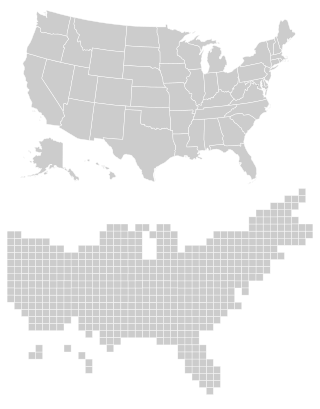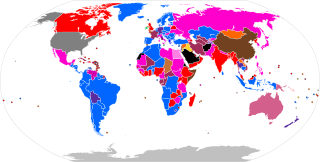Related Research Articles

In the politics of the United States, elections are held for government officials at the federal, state, and local levels. At the federal level, the nation's head of state, the president, is elected indirectly by the people of each state, through an Electoral College. Today, these electors almost always vote with the popular vote of their state. All members of the federal legislature, the Congress, are directly elected by the people of each state. There are many elected offices at state level, each state having at least an elective governor and legislature. There are also elected offices at the local level, in counties, cities, towns, townships, boroughs, and villages; as well as for special districts and school districts which may transcend county and municipal boundaries.
Instant-runoff voting (IRV) is a ranked voting method used in single-winner elections. IRV is also known outside the US as the alternative vote (AV). Today it is in use at a national level to elect the Australian House of Representatives, the National Parliament of Papua New Guinea, the President of Ireland and President of India. In Australia it is also used for elections to the legislative assemblies of all states and territories except Tasmania and the Australian Capital Territory, and for the Tasmanian Legislative Council.

The National Popular Vote Interstate Compact (NPVIC) is an agreement among a group of U.S. states and the District of Columbia to award all their electoral votes to whichever presidential ticket wins the overall popular vote in the 50 states and the District of Columbia. The compact is designed to ensure that the candidate who receives the most votes nationwide is elected president, and it would come into effect only when it would guarantee that outcome.
Electoral reform in Virginia refers to efforts to change the electoral system in the Commonwealth of Virginia. Virginia has undergone much electoral change since its settling in 1607, many of which were required by federal legislation. However, it remains a relatively conservative state in this respect compared to California and others which have experimented with various alternative systems.
Electoral reform in the United States refers to efforts to change American elections and the electoral system used in the United States.
Electoral reform in Alaska refers to efforts to change the voting laws in this U.S. state. U.S. Senator John McCain and other Republicans endorsed a referendum to implement Instant Runoff Voting, after the conservative vote split between the Republican candidate and the Alaskan Independence Party candidate, allowing a Democrat to win the governorship. However, the League of Women Voters opposed it, citing the principle of one man, one vote, and the measure was defeated. Another issue is whether Alaska will join the National Popular Vote Interstate Compact and designate its three electors to the candidate winning the nationwide popular vote, rather than the winner of the state's vote. SB 138, a bill to do just that, was introduced in 2007, but was not approved.
Electoral reform in Vermont has been an issue for decades. Changes in electoral practices have altered how election results represent the intent of Vermont voters and influenced debates in other states.
Electoral reform in Alabama refers to the efforts made to change the voting laws in the Yellowhammer State. In 2006, HB 711 was introduced to use preferential ballots for overseas military voters. It was passed by the Alabama House of Representatives. In March 2007, the 11th Circuit Court of Appeals heard arguments as to whether Alabama election law unfairly restricts third-party and independent candidates from the state ballot. Candidates are required to collect signatures from 3% of the total number of voters who voted in the previous gubernatorial election in order to gain ballot access. Ordinarily, such candidates would gather signatures at the polling place at the party primary, but Alabama made it more difficult by moving the deadline for signature turn-in to the date of the primary. Alabama ranks third nationally in disenfranchising formerly incarcerated citizens. One out of every 14 Alabama residents is disenfranchised. To regain the right to vote, individuals convicted of crimes of “moral turpitude” that have completed a felony sentence must apply to the Alabama Board of Pardons and Paroles for a Certificate of Eligibility to Register to Vote. As soon as you apply for a Pardon you automatically receive the right to vote back. This is the new rule of law and was passed through the House and the Senate due to voter disenfranchisement. In 2007, HB 192 was introduced to join the National Popular Vote Interstate Compact, but it failed in the Constitution & Elections committee.

Electoral reform in California refers to efforts to change election and voting laws in the U.S. state of California.
Electoral reform in Florida refers to efforts to change the voting and election laws in the United States state of Florida.
Electoral reform in Minnesota refers to efforts to change the voting and election laws.
Electoral reform in Maryland refers to efforts, proposals and plans to change the election and voting laws in Maryland. In 2007, Maryland became the first U.S. state to join the National Popular Vote Interstate Compact. Bills have also been introduced to implement instant runoff voting (IRV) statewide, but they have failed, largely due to legislators' concerns about complicating the election process and causing technical problems similar to those encountered by Florida during the 2000 U.S. Presidential election. However, Takoma Park, Maryland adopted IRV in 2006 after it won 84% approval in an advisory ballot measure on November 8, 2005. Maryland is the home of the electoral reform organization Fairvote. In 2007, Maryland's Board of Elections Administrator, Linda Lamone, was quoted in Diebold advertising literature.
Electoral reform in North Carolina refers to efforts to change the voting and election laws in the Tar Heel State.
Electoral reform in Michigan refers to efforts, proposals and plans to change the election and voting laws of Michigan. In 2021, a Sixth Court panel held that Ballot access laws in Michigan curtail independents, as they currently require a political party to submit 38,024 signatures, including 100 signatures from half of all Michigan Congressional districts. The Michigan Third Parties Coalition is seeking to relax those requirements. So far, no bills have been introduced in the Michigan Legislature to join the National Popular Vote Interstate Compact. However in 2023, such legislation was initiated.
Electoral reform in New Mexico refers to efforts to change election and voting laws in this arid U.S. state.

Ranked-choice voting (RCV) can refer to one of several ranked voting methods used in some cities and states in the United States. The term is not strictly defined, but most often refers to instant-runoff voting (IRV) or single transferable vote (STV).
Instant-runoff voting (IRV), also known as ranked-choice voting or the alternative vote (AV), combines ranked voting together with a system for choosing winners from these rankings by repeatedly eliminating the candidate with the fewest first-place votes and reassigning their votes until only one candidate is left. It can be seen as a modified form of a runoff election or exhaustive ballot in which, after eliminating some candidates, the choice among the rest is made from already-given voter rankings rather than from a separate election. Many sources conflate this system of choosing winners with ranked-choice voting more generally, for which several other systems of choosing winners have also been used.

The election of the president and the vice president of the United States is an indirect election in which citizens of the United States who are registered to vote in one of the fifty U.S. states or in Washington, D.C., cast ballots not directly for those offices, but instead for members of the Electoral College. These electors then cast direct votes, known as electoral votes, for president, and for vice president. The candidate who receives an absolute majority of electoral votes is then elected to that office. If no candidate receives an absolute majority of the votes for president, the House of Representatives elects the president; likewise if no one receives an absolute majority of the votes for vice president, then the Senate elects the vice president.
Electoral reform in Oregon refers to efforts to change election and voting laws in the West Coast state of Oregon.

An electoral system or voting system is a set of rules that determine how elections and referendums are conducted and how their results are determined. Electoral systems are used in politics to elect governments, while non-political elections may take place in business, non-profit organisations and informal organisations. These rules govern all aspects of the voting process: when elections occur, who is allowed to vote, who can stand as a candidate, how ballots are marked and cast, how the ballots are counted, how votes translate into the election outcome, limits on campaign spending, and other factors that can affect the result. Political electoral systems are defined by constitutions and electoral laws, are typically conducted by election commissions, and can use multiple types of elections for different offices.
References
- ↑ IRV Washington
- ↑ Instant runoff voting: speaking to voter needs, Krist Novoselic, Seattle Times, Jan. 3, 2007.
- ↑ Bowles for President Archived 2007-10-12 at the Wayback Machine .
- ↑ Felony Disenfranchisement Laws Archived 2009-06-29 at the Library of Congress Web Archives, Brennan Center.
- ↑ "SB5599, 2009". Washington State Legislature. 2009. Retrieved 2009-01-23.